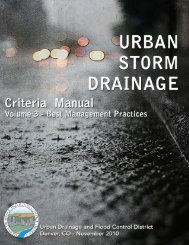Hydraulic Efficiency of Grate and Curb Inlets - Urban Drainage and ...
Hydraulic Efficiency of Grate and Curb Inlets - Urban Drainage and ...
Hydraulic Efficiency of Grate and Curb Inlets - Urban Drainage and ...
You also want an ePaper? Increase the reach of your titles
YUMPU automatically turns print PDFs into web optimized ePapers that Google loves.
Inlet Name<br />
Bar P-1-7/8<br />
Bar P-1-7/8-4<br />
Bar P-1-1/8<br />
Vane <strong>Grate</strong><br />
Table 2-3: <strong>Grate</strong> nomenclature <strong>and</strong> descriptions<br />
Description<br />
parallel bar grate with bar spacing 1-7/8 in. on center<br />
parallel bar grate with bar spacing 1-7/8 in. on center <strong>and</strong> 3/8-in. diameter<br />
lateral rods spaced at 4 in. on center<br />
parallel bar grate with 1-1/8 in. on center bar spacing<br />
curved vane grate with 3-1/4 in. longitudinal bar <strong>and</strong> 4-1/4 in. transverse bar<br />
spacing<br />
45 o Bar 45 o -tilt bar grate with 3-1/4 in. longitudinal bar <strong>and</strong> 4-in. transverse bar<br />
spacing on center<br />
30 o Bar 30 o -tilt bar grate with 3-1/4 in. longitudinal bar <strong>and</strong> 4-in. transverse bar<br />
spacing on center<br />
Reticuline<br />
“honeycomb” pattern <strong>of</strong> lateral bars <strong>and</strong> longitudinal bearing bars<br />
The ratio <strong>of</strong> frontal flow captured by the inlet to the total frontal flow (R f ) can be<br />
expressed by Equation 2-7:<br />
R<br />
f<br />
Q<br />
=<br />
wi<br />
= .0 − 0. 09<br />
Qw<br />
( V −V<br />
)<br />
1 Equation 2-7<br />
o<br />
where:<br />
R f = ratio <strong>of</strong> frontal flow captured to total frontal flow;<br />
Q w = flow rate in the depressed section <strong>of</strong> the gutter (cfs);<br />
Q wi = frontal flow intercepted by the inlet (cfs);<br />
V = velocity <strong>of</strong> flow at the inlet (ft/s) determined from Q/A; <strong>and</strong><br />
V o = splash-over velocity (ft/s).<br />
The relationship given in Equation 2-7 is only valid for splash-over velocity (V o ) less than<br />
cross-sectional averaged velocity (V), otherwise R f = 1 <strong>and</strong> all frontal flow is captured by the<br />
grate. Splash-over velocity is defined as the minimum velocity causing some frontal flow to<br />
escape capture by the grate, <strong>and</strong> may be defined by Equation 2-8:<br />
V<br />
o<br />
= α + βL<br />
− γL<br />
+ ηL<br />
Equation 2-8<br />
e<br />
2<br />
e<br />
3<br />
e<br />
where:<br />
V o = splash-over velocity (ft/s);<br />
L e = effective length <strong>of</strong> grate (ft); <strong>and</strong><br />
α,β,γ,η = constants from Table 2-4.<br />
11
















